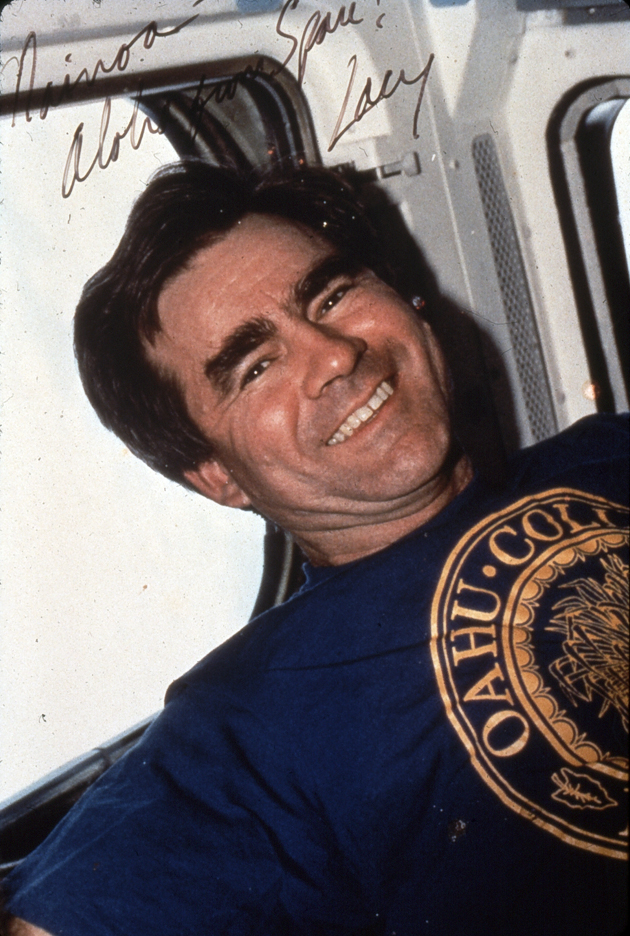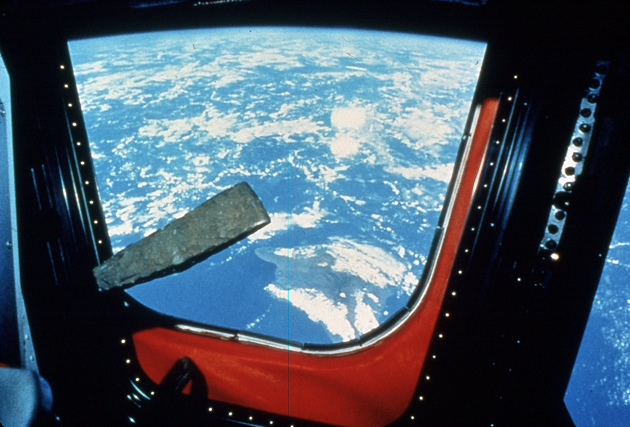Lacy Veach, astronaut and teacher

Nainoa’s tribute to Lacy:
One person who understood the challenges we face and the role of education in meeting the challenge was Colonel Lacy Veach, raised in Hawai'i. He joined the Air Force, flew with the Thunderbird pilots, flew in Vietnam, was shot down twice. A man of great passion.
When he was six years old, he took a comic book and went up to his mother and said, “You see this guy in this comic book, that’s what I’m going to be.” It was a picture of a guy standing on what looked like the moon, with this fishbowl on his head; it was a spaceman. That’s before the Russians even sent a dog up into orbit. How did Lacy know?
I went to one of his school presentations, and I watched the children crowd around him to learn about his great achievements. One child went up to him and poked him I heard him tell the other child, “I’m just checking to see if he’s real.” And then another child asked him, “What does it take to be an astronaut?” Arid he said, “You’ve got to believe in your dreams, and you’ve got to be hard-headed enough to never let them go.”
Lacy was Hawai'i's second astronaut with NASA after Ellison Onizuka, and he flew on two missions of the space shuttle Columbia. He loved Hawai'i and its voyaging canoes and saw immediately the connection between these canoes and Hawai'i's future. On one of his shuttle flights, Lacy was able to stow away an adze stone from his grandfather. The stone came from Keanakako'i, an adze quarry located 12,500 feet up on the slopes of Mauna Kea, a special place where ancient Hawaiians worked in sub-zero temperature to make adzes; Lacy took a photo of his adze floating in space with Mauna Kea behind it framed by the cockpit window, as he was flying 160 miles above earth.

Lacy passed away a year and a half ago from cancer. Before he died, he told me, "Nainoa, you can never believe the beauty of island Earth until you see it in its entirety from space." He was the world's greatest optimist, but he always felt a great concern over the imbalance between human needs and the limited resources of our small planet; over the danger of exponential population growth and depletion of natural resources to support that growth. He would talk about how the 21st century was going to be very different from the century we're leaving. There would be great challenges ahead; there would be places on this planet that are going to be, by our own defintion of quality of life, extremely substandard.
On one of his shuttle flights, a fellow crew member woke Lacey up and told him to look out the window--they were passing over the Hawaiian Islands. Lacey could see all the Islands, and he could see his whole spirit and soul here. He saw the entire planet in one vision. "The best place to think about the fate of our planet is right here in the islands. If we can create a model for well-being here in Hawai'i, we can make a contribution to the entire world." He wanted to come home. On his visits to the islands, he talked with schoolchildren. On one visit, a child went up to him and poked him. I heard him tell another child, "I'm just checking to see if he's real." And then another child asked him, "What does it take to be an astronaut?" And Lacey said, "You've got to believe in your dreams, and you've got to be hard-headed enough to never let them go."
One day he told me, "I'm going to fly two more times in the shuttle. Then I'm coming home." He'd been away from Hawai'i since high school. "I'm coming home to help children who want to learn."
Lacy Veach, NASA Profile
NAME: Charles Lacy Veach (Mr.)
NASA Astronaut
PERSONAL DATA: Born September 18, 1944, in Chicago, Illinois, but considered Honolulu, Hawaii, to be his hometown. Married to the former Alice Meigs Scott of Waycross, Georgia. Two children. He enjoyed surfing, bicycling, reading, and activities with his family. His parents, Mr. and Mrs. Marshall E. Veach, reside in Honolulu, Hawaii. Her mother, Mrs. Myrtle Lee Scott, resides in Augusta, Georgia. Her father, Commander Frank V. Scott, Jr., is deceased.
EDUCATION: Graduated from Punahou School, Honolulu, Hawaii, in 1962; received a bachelor of science degree in engineering management from the U.S. Air Force Academy in 1966.
SPECIAL HONORS: Distinguished Flying Cross with 2 Oak Leaf Clusters, Air Medal with 13 Oak Leaf Clusters, Air Force Commendation Medal with 1 Oak Leaf Cluster, and Purple Heart.
EXPERIENCE: Veach was commissioned in the United States Air Force upon graduation from the Air Force Academy. He received his pilot wings at Moody Air Force Base, Georgia, in 1967, and then attended fighter gunnery school at Luke Air Force Base, Arizona. Over the next 14 years, he served as a USAF fighter pilot, flying the F-100 Super Sabre, the F-111, and the F-105 Thunderchief, on assignments in the United States, Europe, and the Far East, including a 275-mission combat tour in the Republic of Vietnam. In 1976 and 1977, he was a member of the USAF Air Demonstration Squadron, the Thunderbirds. Veach left active duty in 1981, but continued to fly fighters as an F-16 pilot with the Texas Air National Guard. He had logged over 5,000 flying hours.
NASA EXPERIENCE: Veach came to work for NASA in January 1982 as an engineer and research pilot at the Johnson Space Center in Houston. His primary duty was as an instructor pilot in the Shuttle Training Aircraft, the highly modified Gulfstream II used to train astronaut pilots to land the Space Shuttle.
Veach was selected as an astronaut candidate in May 1984, and became an astronaut in June 1985. He held a variety of technical assignments, and had flown as a mission specialist on two Space Shuttle missions, STS-39 in 1991 and STS-52 in 1992. He had logged 436.3 hours in space. Most recently, Lacy had worked as the lead astronaut for the development and operation of robotics for the International Space Station.
On STS-39, Veach was responsible for operating a group of instruments which included an ultraviolet astronomical camera, an x-ray telescope, and a liquid helium-cooled infrared telescope which performed landmark observations of the Earth's atmosphere and the Aurora Australis (the Southern Lights). The 8-day unclassified Department of Defense mission aboard the Orbiter Discovery launched from the Kennedy Space Center in Florida on April 28, 1991, and landed at Kennedy on May 6, 1991.
STS-52 was a 10-day mission aboard the Orbiter Columbia during which the crew successfully deployed the Laser Geodynamic Satellite (LAGEOS), a joint Italian-American project. They also operated the first U.S. Microgravity Payload (USMP) with French and American experiments. Veach was the primary Remote Manipulator System (RMS) operator on the mission, supporting the initial flight tests of the Canadian-built Space Vision System (SVS). STS-52 launched from the Kennedy Space Center in Florida on October 22, 1992, and landed at Kennedy on November 1, 1992.
Lacy Veach died in Houston, Texas, on October 3, 1995, of cancer.
